Natural Disasters
Natural disasters such as flood, fire, earthquake, tornado and windstorm affect thousands of people every year. You should know what your risks are and prepare to protect yourself, your family and community.
Recognizing an impending hazard and knowing what to do to protect yourself and your family will help you take effective steps to prepare beforehand and aid recovery after the event.
Some of the things you can do to prepare for the unexpected, such as assembling a supply kit and developing a family emergency plan, are the same for all types of hazards. However each emergency is unique and knowing the actions to take for each threat will impact the specific decisions and preparations you make. By learning about these specific threats, you are preparing yourself to react in an emergency.

Fire drills are a big part of being safe in school: They prepare you for what you need to do in case of a fire. But what if there was a fire where you live? Would you know what to do? Talking about fires can be scary because no one likes to think about people getting hurt or their things getting burned. But you can feel less worried if you are prepared.
It's a good ideas for families to talk about what they would do to escape a fire. Different families will have different strategies. Some kids live in one-story houses and other kids live in tall buildings. You'll want to talk about escape plans and escape routes, so let's start there.
Know Your Way Out
An escape plan can help every member of a family get out of a burning house. The idea is to get outside quickly and safely. Smoke from a fire can make it hard to see where things are, so it's important to learn and remember the different ways out of your home. How many exits are there? How do you get to them from your room? It's a good idea to have your family draw a map of the escape plan.
It's possible one way out could be blocked by fire or smoke, so you'll want to know where other ones are. And if you live in an apartment building, you'll want to know the best way to the stairwell or other emergency exits.
Safety Steps
If you're in a room with the door closed when the fire breaks out, you need to take a few extra steps:
- Check to see if there's heat or smoke coming in the cracks around the door. (You're checking to see if there's fire on the other side.)
- If you see smoke coming under the door — don't open the door!
- If you don't see smoke — touch the door. If the door is hot or very warm — don't open the door!
- If you don't see smoke — and the door is not hot — then use your fingers to lightly touch the doorknob. If the doorknob is hot or very warm — don't open the door!
If the doorknob feels cool, and you can't see any smoke around the door, you can open the door very carefully and slowly. When you open the door, if you feel a burst of heat, or smoke pours into the room, quickly shut the door and make sure it is really closed. If there's no smoke or heat when you open the door, go toward your escape route exit.
Stay Low
If you can see smoke in the house, stay low to the ground as you make your way to the exit. In a fire, smoke and poisonous air hurt more people than the actual flames do. You'll breathe less smoke if you stay close to the ground.
Smoke naturally rises, so if there is smoke while you're using your escape route, staying low means you can crawl under most of it. You can drop to the floor and crawl on your hands and knees below the smoke.
Exiting through a door that leads outside should be your first choice as an escape route, but also ask your parents about windows and if they would be possible escape routes. Even windows on a higher floor could be safe escape routes if you had help, like from a firefighter or another adult.
Ask your parents to teach you how to unlock the windows, open them, and remove the screen, if needed. Make sure you only do this in an emergency! Lots of kids are injured because they fall out of windows.
Sometimes, families even have collapsible rescue ladders that can be used to escape from upper floors of a house. If you have one, ask your mom or dad to show you how it works.
In addition to planning your escape routes, you'll also want to know where family members will meet outside. This is helpful because then everyone shows up in one place and you'll know that everyone is safe. You might choose the front porch of a neighbor's house or some other nearby spot.
It's normal to worry about your pets or a favorite toy, but if there is a fire, you have to leave them behind. The most important thing is that you get out safely. It's also important to know that you shouldn't stay in the house any longer than you must — not even to call 911. Someone else can make that call from outside.
Once you're out, do not go back in for anything — even pets. You can tell the fire rescue people about any pets that were left behind and they may be able to help.
What if You Can't Get Out Right Away?
If you can't get out fast, because fire or smoke is blocking an escape route, you'll want to yell for help. You can do this from an open window or call 911 if you have a phone with you.
Even if you're scared, never hide under the bed or in a closet. Then, firefighters will have a hard time finding you. Know that firefighters or other adults will be looking for you to help you out safely. The sooner they find you, the sooner you both can get out.
In the meanwhile, keep heat and smoke from getting through the door by blocking the cracks around the door with sheets, blankets, and/or clothing. If there is a window in the room that is not possible to escape from, open it wide and stand in front of it. If you can grab a piece of clothing or a towel, place it over your mouth to keep from breathing in the smoke. This works even better if you wet the cloth first.
Home Drills
It's great to talk about emergency plans, but it's even better if you practice them, like the fire drills you have at school. Having a fire drill at home gives everyone a chance to see how they would react in a real emergency. You can see how quickly and safely everyone can get out of the house. Your family should practice this drill twice a year, every year. It's also a good time to remind your parents to change the batteries in the smoke alarms.
A good rule of thumb during a home fire drill is to see if your family can safely get out the house using the escape routes and meet outside at the same place within 3 minutes. For an extra challenge, you might try variations, like pretending that the front door was blocked and you couldn't get out that way.
If Your Clothes Catch Fire
A person's clothes could catch fire during a fire or by accident, like if you step too close to a candle. If this happens, don't run! Instead, stop, drop to the ground, cover your face with your hands, and roll. This will cut off the air and put out the flames. An easy way to remember this is: Stop, Drop, and Roll!
Preventing Fires
Every year, kids of all ages start over 35,000 fires that hurt people and damage property. You can do your part to prevent fires by never playing with matches, lighters, and other fire sources. Also stay away from fireplaces, candles, and stoves.
By following this advice, you'll be doing important work — preventing fires in the first place!
http://kidshealth.org/kid/watch/er/fire_safety.html#
Earthquakes
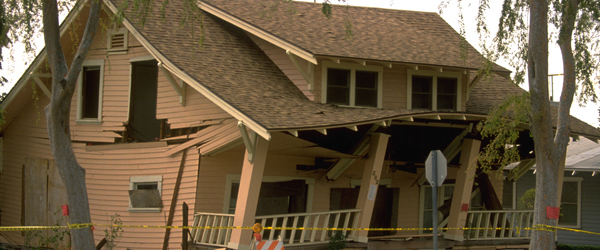 One of the most frightening and destructive phenomena of nature is a severe earthquake and its terrible aftereffects. An earthquake is the sudden, rapid shaking of the earth, caused by the breaking and shifting of subterranean rock as it releases strain that has accumulated over a long time.
One of the most frightening and destructive phenomena of nature is a severe earthquake and its terrible aftereffects. An earthquake is the sudden, rapid shaking of the earth, caused by the breaking and shifting of subterranean rock as it releases strain that has accumulated over a long time.
For hundreds of millions of years, the forces of plate tectonics have shaped the earth, as the huge plates that form the earth’s surface slowly move over, under and past each other. Sometimes, the movement is gradual. At other times, the plates are locked together, unable to release accumulated energy. When the accumulated energy grows strong enough, the plates break free. If the earthquake occurs in a populated area, it may cause many deaths and injuries and extensive property damage.
While earthquakes are sometimes believed to be a West Coast occurrence, there are actually 45 states and territories throughout the United States that are at moderate to high risk for earthquakes including the New Madrid fault line in Central U.S.
The 2011 East Coast earthquake illustrated the fact that it is impossible to predict when or where an earthquake will occur, so it is important that you and your family are prepared ahead of time.
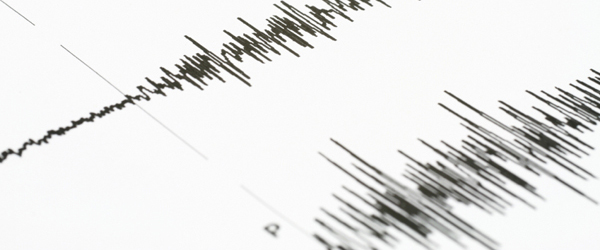 Before an Earthquake
Before an Earthquake
The following are things you can do to protect yourself, your family and your property in the event of an earthquake.
- To begin preparing, you should build an emergency kit and make a family communications plan.
- Fasten shelves securely to walls.
- Place large or heavy objects on lower shelves.
- Store breakable items such as bottled foods, glass, and china in low, closed cabinets with latches.
- Fasten heavy items such as pictures and mirrors securely to walls and away from beds, couches and anywhere people sit.
- Brace overhead light fixtures and top heavy objects.
- Repair defective electrical wiring and leaky gas connections. These are potential fire risks. Get appropriate professional help. Do not work with gas or electrical lines yourself.
- Install flexible pipe fittings to avoid gas or water leaks. Flexible fittings are more resistant to breakage.
- Secure your water heater, refrigerator, furnace and gas appliances by strapping them to the wall studs and bolting to the floor. If recommended by your gas company, have an automatic gas shut-off valve installed that is triggered by strong vibrations.
- Repair any deep cracks in ceilings or foundations. Get expert advice if there are signs of structural defects.
- Be sure the residence is firmly anchored to its foundation.
- Store weed killers, pesticides, and flammable products securely in closed cabinets with latches and on bottom shelves.
- Locate safe spots in each room under a sturdy table or against an inside wall. Reinforce this information by moving to these places during each drill.
- Hold earthquake drills with your family members: Drop, cover and hold on.
During an Earthquake
Drop, cover and Hold On. Minimize your movements to a few steps to a nearby safe place and if you are indoors, stay there until the shaking has stopped and you are sure exiting is safe.
If Indoors
- DROP to the ground; take COVER by getting under a sturdy table or other piece of furniture; and HOLD ON until the shaking stops. If there isn’t a table or desk near you, cover your face and head with your arms and crouch in an inside corner of the building.
- Stay away from glass, windows, outside doors and walls, and anything that could fall, such as lighting fixtures or furniture.
- Stay in bed if you are there when the earthquake strikes. Hold on and protect your head with a pillow, unless you are under a heavy light fixture that could fall. In that case, move to the nearest safe place.
- Do not use a doorway except if you know it is a strongly supported, load-bearing doorway and it is close to you. Many inside doorways are lightly constructed and do not offer protection..
- Stay inside until the shaking stops and it is safe to go outside. Do not exit a building during the shaking. Research has shown that most injuries occur when people inside buildings attempt to move to a different location inside the building or try to leave.
- DO NOT use the elevators.
- Be aware that the electricity may go out or the sprinkler systems or fire alarms may turn on.
If Outdoors
- Stay there.
- Move away from buildings, streetlights, and utility wires.
- Once in the open, stay there until the shaking stops. The greatest danger exists directly outside buildings, at exits and alongside exterior walls. Many of the 120 fatalities from the 1933 Long Beach earthquake occurred when people ran outside of buildings only to be killed by falling debris from collapsing walls. Ground movement during an earthquake is seldom the direct cause of death or injury. Most earthquake-related casualties result from collapsing walls, flying glass, and falling objects.
If in a Moving Vehicle
- Stop as quickly as safety permits and stay in the vehicle. Avoid stopping near or under buildings, trees, overpasses, and utility wires.
- Proceed cautiously once the earthquake has stopped. Avoid roads, bridges, or ramps that might have been damaged by the earthquake.
If Trapped Under Debris
- Do not light a match.
- Do not move about or kick up dust.
- Cover your mouth with a handkerchief or clothing.
- Tap on a pipe or wall so rescuers can locate you. Use a whistle if one is available. Shout only as a last resort. Shouting can cause you to inhale dangerous amounts of dust.
After an Earthquake
- When the shaking stops, look around to make sure it is safe to move. Then exit the building.
- Expect aftershocks. These secondary shockwaves are usually less violent than the main quake but can be strong enough to do additional damage to weakened structures and can occur in the first hours, days, weeks, or even months after the quake.
- Help injured or trapped persons. Remember to help your neighbors who may require special assistance such as infants, the elderly and people with access and functional needs. Give first aid where appropriate. Do not move seriously injured persons unless they are in immediate danger of further injury. Call for help.
- Look for and extinguish small fires. Fire is the most common hazard after an earthquake.
- Listen to a battery-operated radio or television for the latest emergency information.
- Be aware of possible tsunamis if you live in coastal areas. These are also known as seismic sea waves (mistakenly called "tidal waves"). When local authorities issue a tsunami warning, assume that a series of dangerous waves is on the way. Stay away from the beach.
- Use the telephone only for emergency calls.
- Go to a designated public shelter if your home had been damaged and is no longer safe. Text SHELTER + your ZIP code to 43362 (4FEMA) to find the nearest shelter in your area (example: shelter 12345).
- Stay away from damaged areas. Stay away unless your assistance has been specifically requested by police, fire, or relief organizations. Return home only when authorities say it is safe.
- Be careful when driving after an earthquake and anticipate traffic light outages.
- After it is determined that its’ safe to return, your safety should be your primary priority as you begin clean up and recovery.
- Open cabinets cautiously. Beware of objects that can fall off shelves.
- Find out how to keep food safe during and after and emergency by visiting: http://www.foodsafety.gov/keep/emergency/index.html
- Put on long pants, a long-sleeved shirt, sturdy shoes and work gloves to protect against injury from broken objects.
- Clean up spilled medicines, bleaches, gasoline or other flammable liquids immediately. Leave the area if you smell gas or fumes from other chemicals.
- Inspect the entire length of chimneys for damage. Unnoticed damage could lead to a fire.
- Inspect utilities.
- Check for gas leaks. If you smell gas or hear blowing or hissing noise, open a window and quickly leave the building. Turn off the gas at the outside main valve if you can and call the gas company from a neighbor's home. If you turn off the gas for any reason, it must be turned back on by a professional.
- Look for electrical system damage. If you see sparks or broken or frayed wires, or if you smell hot insulation, turn off the electricity at the main fuse box or circuit breaker. If you have to step in water to get to the fuse box or circuit breaker, call an electrician first for advice.
- Check for sewage and water lines damage. If you suspect sewage lines are damaged, avoid using the toilets and call a plumber. If water pipes are damaged, contact the water company and avoid using water from the tap. You can obtain safe water by melting ice cubes.
Floods
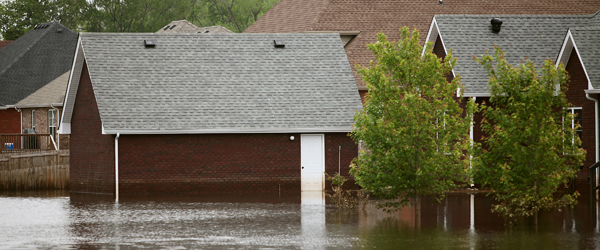 Floods are one of the most common hazards in the United States, however not all floods are alike. Some floods develop slowly, while others such a flash floods, can develop in just a few minutes and without visible signs of rain. Additionally, floods can be local, impacting a neighborhood or community, or very large, affecting entire river basins and multiple states.
Floods are one of the most common hazards in the United States, however not all floods are alike. Some floods develop slowly, while others such a flash floods, can develop in just a few minutes and without visible signs of rain. Additionally, floods can be local, impacting a neighborhood or community, or very large, affecting entire river basins and multiple states.
Flash floods can occur within a few minutes or hours of excessive rainfall, a dam or levee failure, or a sudden release of water held by an ice jam. Flash floods often have a dangerous wall of roaring water carrying rocks, mud and other debris. Overland flooding, the most common type of flooding event typically occurs when waterways such as rivers or streams overflow their banks as a result of rainwater or a possible levee breach and cause flooding in surrounding areas. It can also occur when rainfall or snowmelt exceeds the capacity of underground pipes, or the capacity of streets and drains designed to carry flood water away from urban areas.
Be aware of flood hazards no matter where you live or work, but especially if you are in low-lying areas, near water, behind a levee or downstream from a dam. Even very small streams, gullies, creeks, culverts, dry streambeds or low-lying ground that appear harmless in dry weather can flood.
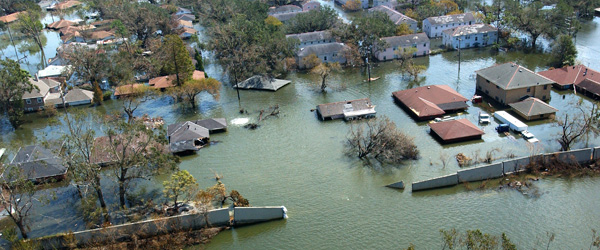 Before a Flood
Before a Flood
What would you do if your property were flooded? Are you prepared?
Even if you feel you live in a community with a low risk of flooding, remember that anywhere it rains, it can flood. Just because you haven't experienced a flood in the past, doesn't mean you won't in the future. Flood risk isn't just based on history; it's also based on a number of factors including rainfall , topography, flood-control measures, river-flow and tidal-surge data, and changes due to new construction and development.
Flood-hazard maps have been created to show the flood risk for your community, which helps determine the type of flood insurance coverage you will need since standard homeowners insurance doesn't cover flooding. The lower the degree of risk, the lower the flood insurance premium.
In addition to having flood insurance, knowing following flood hazard terms will help you recognize and prepare for a flood.
To prepare for a flood, you should:
- Build an emergency kit and make a family communications plan.
- Avoid building in a floodplain unless you elevate and reinforce your home.
- Elevate the furnace, water heater and electric panel in your home if you live in an area that has a high flood risk.
- Consider installing "check valves" to prevent flood water from backing up into the drains of your home.
- If feasible, construct barriers to stop floodwater from entering the building and seal walls in basements with waterproofing compounds.
During a Flood
If a flood is likely in your area, you should:
- Listen to the radio or television for information.
- Be aware that flash flooding can occur. If there is any possibility of a flash flood, move immediately to higher ground. Do not wait for instructions to move.
- Be aware of stream, drainage channels, canyons and other areas known to flood suddenly. Flash floods can occur in these areas with or without typical warnings such as rain clouds or heavy rain.
If you must prepare to evacuate, you should do the following:
- Secure your home. If you have time, bring in outdoor furniture. Move essential items to an upper floor.
- Turn off utilities at the main switches or valves if instructed to do so. Disconnect electrical appliances. Do not touch electrical equipment if you are wet or standing in water.
If you have to leave your home, remember these evacuation tips:
- Do not walk through moving water. Six inches of moving water can make you fall. If you have to walk in water, walk where the water is not moving. Use a stick to check the firmness of the ground in front of you.
- Do not drive into flooded areas. If floodwaters rise around your car, abandon the car and move to higher ground if you can do so safely. You and the vehicle can be swept away quickly.
- Do not camp or park your vehicle along streams, rivers or creeks, particularly during threatening conditions.
Landslides & Debris Flow
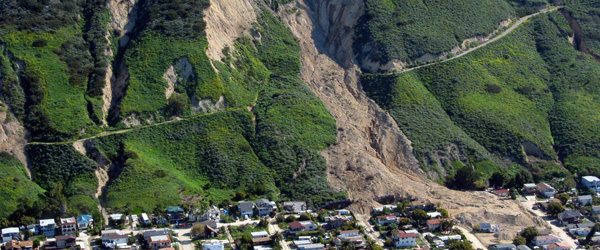 Landslides occur in all U.S. states and territories and can be caused by a variety of factors including earthquakes, storms, volcanic eruptions, fire and by human modification of land. Landslides can occur quickly, often with little notice and the best way to prepare is to stay informed about changes in and around your home that could signal that a landslide is likely to occur.
Landslides occur in all U.S. states and territories and can be caused by a variety of factors including earthquakes, storms, volcanic eruptions, fire and by human modification of land. Landslides can occur quickly, often with little notice and the best way to prepare is to stay informed about changes in and around your home that could signal that a landslide is likely to occur.
In a landslide, masses of rock, earth or debris move down a slope. Debris and mud flows are rivers of rock, earth, and other debris saturated with water. They develop when water rapidly accumulates in the ground, during heavy rainfall or rapid snowmelt, changing the earth into a flowing river of mud or “slurry.” They can flow rapidly, striking with little or no warning at avalanche speeds. They also can travel several miles from their source, growing in size as they pick up trees, boulders, cars and other materials.
Landslide problems can be caused by land mismanagement, particularly in mountain, canyon and coastal regions. In areas burned by forest and brush fires, a lower threshold of precipitation may initiate landslides. Land-use zoning, professional inspections, and proper design can minimize many landslide, mudflow, and debris flow problems.
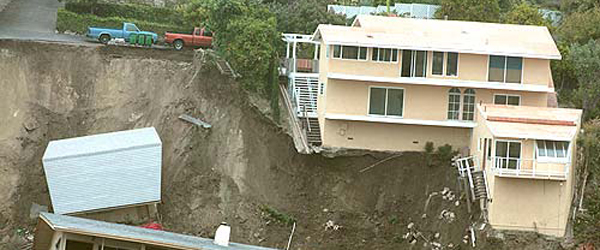 Before a Landslide
Before a Landslide
The following are things you can do to protect yourself, your family and your property from the effects of a landslide or debris flow:
- To begin preparing, you should build an emergency kit and make a family communications plan.
- Prepare for landslides by following proper land-use procedures - avoid building near steep slopes, close to mountain edges, near drainage ways or along natural erosion valleys.
- Become familiar with the land around you. Learn whether debris flows have occurred in your area by contacting local officials. Slopes where debris flows have occurred in the past are likely to experience them in the future.
- Get a ground assessment of your property.
- Consult a professional for advice on appropriate preventative measures for your home or business, such as flexible pipe fittings, which can better resist breakage.
- Protect your property by planting ground cover on slopes and building retaining walls.
- In mudflow areas, build channels or deflection walls to direct the flow around buildings. Be aware, however, if you build walls to divert debris flow and the flow lands on a neighbor's property, you may be liable for damages.
- If you are at risk from a landslide talk to your insurance agent. Debris flow may be covered by flood insurance policies from the National Flood Insurance Program (NFIP).
Recognize Landslide Warning Signs
During a Landslide
- During a severe storm, stay alert and awake. Many deaths from landslides occur while people are sleeping.
- Listen to local news stations on a battery-powered radio for warnings of heavy rainfall.
- Listen for unusual sounds that might indicate moving debris, such as trees cracking or boulders knocking together.
- Move away from the path of a landslide or debris flow as quickly as possible. The danger from a mudflow increases near stream channels and with prolonged heavy rains. Mudflows can move faster than you can walk or run. Look upstream before crossing a bridge and do not cross the bridge if a mudflow is approaching.
- Avoid river valleys and low-lying areas.
- If you are near a stream or channel, be alert for any sudden increase or decrease in water flow and notice whether the water changes from clear to muddy. Such changes may mean there is debris flow activity upstream so be prepared to move quickly.
- Curl into a tight ball and protect your head if escape is not possible.
After a Landslide
- Go to a designated public shelter if you have been told to evacuate or you feel it is unsafe to remain in your home. Text SHELTER + your ZIP code to 43362 (4FEMA) to find the nearest shelter in your area (example: shelter 12345).
- Stay away from the slide area. There may be danger of additional slides.
- Listen to local radio or television stations for the latest emergency information.
- Watch for flooding, which may occur after a landslide or debris flow. Floods sometimes follow landslides and debris flows because they may both be started by the same event.
- Check for injured and trapped persons near the slide, without entering the direct slide area. Direct rescuers to their locations.
- Look for and report broken utility lines and damaged roadways and railways to appropriate authorities. Reporting potential hazards will get the utilities turned off as quickly as possible, preventing further hazard and injury.
- Check the building foundation, chimney, and surrounding land for damage. Damage to foundations, chimneys, or surrounding land may help you assess the safety of the area.
- Replant damaged ground as soon as possible since erosion caused by loss of ground cover can lead to flash flooding and additional landslides in the near future.
- Seek advice from a geotechnical expert for evaluating landslide hazards or designing corrective techniques to reduce landslide risk. A professional will be able to advise you of the best ways to prevent or reduce landslide risk, without creating further hazard.











No comments:
Post a Comment